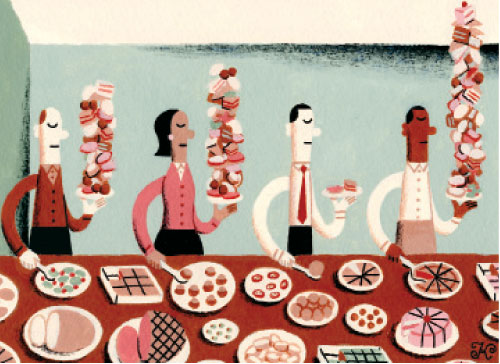
'Tis the Season to Overeat
How to survive the holiday buffet without packing on the pounds.
By Jeff Csatari
Illustration by James Kaczman
 |
Swedish meatballs, broiled scallops wrapped in bacon, carved HoneyBaked Ham, fresh rolls, roasted turkey breast, olives, pickles, hot peppers filled with mozzarella and prosciutto, apple pie, walnut roll, chocolate-dipped cream puffs.
Getting hungry?
Oops! Don’t miss Aunt Ethel’s chocolate cake/chocolate pudding concoction topped with crushed Oreo cookies that she calls, with no hint of irony, “Death by Chocolate.”
That’s just a quick peek at a buffet table at a typical holiday party. No doubt you’ve bellied up to more than a few, and you inherently know the power the smorgasbord wields over reasonable self-control.
Researchers say that what we eat and how much we consume is determined not by hunger, primarily, but by environmental cues such as color, aroma, variety, and volume. “People eat with their eyes, and their eyes trick their stomachs,” says Brian Wansink, Ph.D., director of the Cornell University Food and Brand Lab and author of Mindless Eating: Why We Eat More Than We Think. “The more variety we see on a buffet table, the more we eat.”
A study in the Journal of Consumer Research in which people were given bowls of M&M’s candies demonstrates this phenomenon. When given a bowl filled with M&M’s in seven colors, participants ate on average 56 M&M’s. When three colors were added to the bowls, raising the number of colors to 10, the munchers consumed 99 M&M’s, a 77 percent increase.
Food marketing researchers can be devious. In another study, people were given soup in trick bowls that were rigged to slowly refill as the people ate. The experiment showed that people consumed 73 percent more soup from the “bottomless” bowls than did people who ate from the regular bowls and, get this, the overeaters believed they were eating the same amount as the people with regular bowls.
Nutritionists and experts in consumer behavior agree: Easy access to large quantities of food or large varieties leads to mindless eating. And at no other time of the year does there seem to be more buffet-table opportunities than right now. It has been estimated that the average American consumes an extra 600 calories per day between Thanksgiving and New Year’s Day. If you do the math, that turns out to about six pounds of weight added in the last 36 days of the year.
There’s no avoiding holiday buffets if you wish to celebrate the season with family and friends. But there are many healthful ways to navigate the buffet danger zone and leave the party without having to let out a belt notch.
“You don’t have to turn Thanksgiving into an Olympic eating event,” says registered dietician Leslie Bonci, MPH, the director of sports medicine nutrition in the Center for Sports Medicine at the University of Pittsburgh Medical Center. Approach the buffet with a predetermined strategy to avoid overeating, says Bonci, who suggests what she calls the four P’s plan: prioritize, position (sit far from the food), pace, and portion control.
Just those four strategies alone should be enough to help you enjoy a party without depriving yourself of a little well-deserved holiday fun.
Happy holidays!
Jeff Csatari is the author of the best-selling book The Belly Off! Diet and Norman Rockwell's Boy Scouts of America, which he co-wrote with his father, Joseph Csatari, the official artist of the BSA.
What a Real Serving Looks Like
|